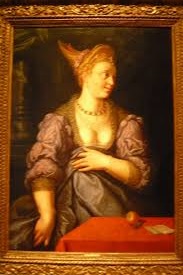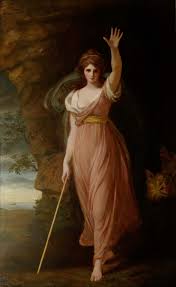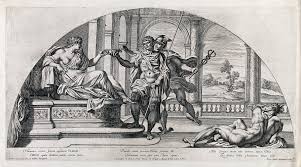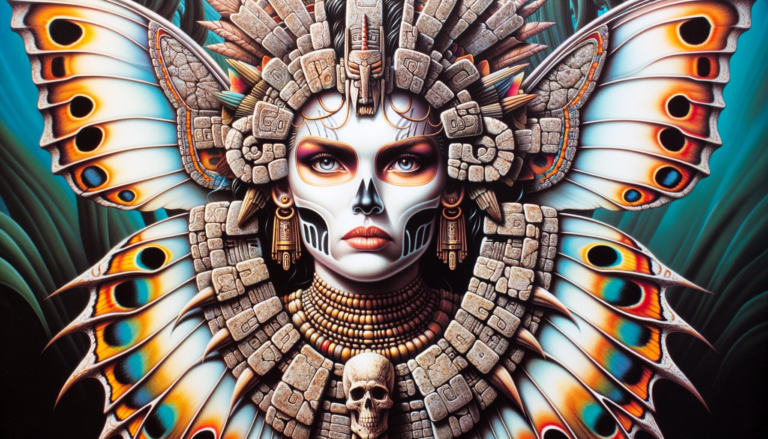Female Characters In The Odyssey – Helpers and Hindrances
What roles are played by the female characters in the odyssey?

They are either Helpers or Hindrances. Women in the Odyssey offer an insight into the roles of women in general in ancient Greece during the time of the epic’s writing. The society of the day was patriarchal. Women were considered weak yet cunning. Men were strong, brave, courageous.
Greek mythology stretching back to Pandora portrayed women as often-foolish and weak-willed, with their curiosity far too strong for their own good, leaving them in need of a man to guide and control them. In the origins story of Greek mythology, Pandora was a woman who was given a box containing all of the woes of the world. Warned not to open it, she was unable to resist taking a peek. By opening the box, she released all of the woes that plague humanity to this day.
Like Eve of Christian mythology, Pandora is held responsible for all of the challenges and difficulties faced by men of the world. Women, in the Odyssey, live under the shadow of Pandora, and the disfavor of the gods. They are forever in need of the leading of men to prevent them from wreaking havoc and creating chaos in the world.
Women were often used as pawns, whether in human affairs or those of the gods. Women were given and taken in marriage, held as objects of both desire and scorn. Helen, a great beauty, was stolen away, causing the Trojan war. She was criticized for giving in to her captors, costing thousands of soldier’s lives. No real mention is made of what Helen herself preferred in terms of where she would have liked to reside or who she wished to marry. She is only the object of desire and blame.
Symbolism About Women In The Odyssey
Women in the Odyssey fell into one of a handful of categories- they could be independent of male leading and control, and therefore dangerous. A woman could be a source of temptation and an object of sexual desire. A woman could be a wife or woman of virtue, to be defended and admired. Finally, a woman could be a chattel, a slave or a wife used as a pawn as men wrestled over power and control.
Most women who worked to assist Odysseus were portrayed as daughters or wives. These women sought to support Odysseus, moving him forward in his journey. They exemplified and promoted the idea of xenia – hospitality. This virtue was considered a moral necessity. By offering hospitality to travelers and strangers, citizens often entertained gods unaware. The idea of xenia is a powerful one that is portrayed throughout the epic. Many characters’ fates are dependent upon how they received Odysseus when he came to them unknown.
The women who were hindered to Odysseus were portrayed as lacking virtue, weak-willed, willful, or stubborn. They were prone to lust and had little self-control. The use of cunning is rarely portrayed as being a good thing. A notable exception is Penelope, Odysseus’ wife. While awaiting his return, she turns away potential suitors by telling them she will consider their suits when she has finished her tapestry. For a time, she can lengthen her refusal by undoing all of her work each night. When her trick is found out, she is forced to finish the tapestry. Even in a virtuous woman, the use of cunning and cleverness is punished.
Several times, women in the chattel position had opportunities to assist Odysseus on his journey. Those women were portrayed as virtuous. There is an interesting lack of acknowledgement of their position. The slave who assists Odysseus when he returns to Ithaca, for example, does so under the threat of death.
Women in Ancient Greece
The Odyssey portrayal of women is heavily patriarchal, as it presents women as subtly less and weaker than men in nearly every case. Even Athena, the proud warrior goddess, who is a champion to mothers and young women, is subject to fits of rage and poor judgment moments. Women were valued for what they were able to offer to the men of the story arc. Even the dead with whom Odysseus converses introduce themselves by speaking of their husbands and children and their sons’ exploits. Women’s value is clearly delineated by their relationships to and value offered to men.
While little is known of the day to day lives of the original readers of the epic, the poem gives some insight into the culture. There is a strict hierarchy of class and gender at all levels. Stepping outside of those lines was heavily frowned upon for either men or women. Anyone who refuses to fall in line with the roles laid out by society and the gods’ risks having fate treat them less than kindly.
Women Fighting Back
As Odysseus travels, he does meet some independent women. Circe, a witch, is clearly a hindrance to his travels and demands he remains with her for a year as her lover before releasing him to continue his journey. Calypso, a nymph, traps him and keeps him enslaved for seven years before finally agreeing to release him when persuaded by god Hermes. In both cases, the women are independent of male influence. In their unguided and uncontrolled state, they are portrayed as “witches” and “nymphs,” creatures that possess undeniable power but little in the way of character or self-control. Their desire is entirely selfish. They show no caring for Odysseus or his mission or his crew. Circe wantonly converts his crewmen to pigs, while Calypso keeps him prisoner, preventing him from continuing his journey.
Circe’s character provides a foil for the noble and clever Odysseus, who does not beat her with brute strength but rather uses her own weakness- her lust- against her. Calypso provides a contrast. While Odysseus longs for his home and expresses a natural feeling for his wife, she callously tries to lure him into remaining with her. Even her offer of immortality is not enough to sway him from his desire to return to his home.
Through the Needle’s Eye
Women in the Odyssey are scarce. Of the 19 main characters mentioned in the play, only seven are female, and one is a sea monster. Of those, four, the goddess Athena, Eurycleia the slave, and Nausicaa and her mother Arete, princess and queen of the Phaeacians, assist Odysseus rather than hinder his journey.
Each is cast in the role of mother or daughter. Athena is a mentor, a mother-figure to Odysseus, pleading his case to the other gods and intervening, often appearing as the “mentor” to Odysseus himself. Eurycleia, despite her status as a slave, was a nurse to Odysseus and later his son. She is also cast in a motherly role. Nausicaa and her mother are a mother-daughter team who use their virtue to support and assist their husbands and fathers, ensuring that the Phaeacians’ proud leader upholds the natural law of Xenia. The path to virtue, admiration and respect for a woman in the Odyssey was a narrow one indeed.
Wicked Witches and Other Harlots

Of the Odyssey characters who are female, only Athena, Circe, and Calypso are independent agents. Athena seems to act of her own will when she pleads Odysseus’ case with the other gods. Even she, a powerful goddess, is bound to Zeus’ will. Circe requires no man on her isolated island, treating any who come near with the utmost disdain. She turns Odysseus’ crew into swine, a rather apt reflection of her opinion of males in general. She is portrayed as careless, thoughtless, and cruel until Odysseus, with Hermes’ help, outsmarts her. He threatens her by promising not to harm him.
Impressed with Odysseus’ skill in dodging her ruse, Circe then turns from hating men to taking Odysseus as her lover for a year. The theme of a woman falling in love with or desiring a man who has defeated them is a common one, and Circe is an archetype character who follows her role. Her lustful and hedonistic habits contrast with Odysseus, who tries to lead his men in the right direction to get them home. His year with Circe is a sacrifice to gain her agreement to turn his men back to their human forms and escape.
Calypso, the nymph, represents a woman’s sexuality. As a nymph, she is desirable and, unlike the virtuous Mother and Daughter archetype characters, seeks and enjoys physical relationships with men. She shows little concern for what Odysseus wants, keeping him prisoner and trying to bribe and him to stay with her despite his desire to return home to Penelope, his wife.
Chattel Characters in the Odyssey

Another example of women’s use in the Odyssey as mere pawns or tools is the wording used to describe the wife and daughter of the king of the cannibal giants, Antiphates. Upon arriving on Lamos’ shores, the home of the Laestrygones, Odysseus moors his own ship in a hidden cove and sends the other eleven ships on. He has learned from past disasters and holds back while his men investigate this place. Unfortunately for the other eleven ships, the welcome they receive is not a kind one. Once more, they are betrayed by a woman. The wife and daughter of the king Antiphates are not named in the narrative as Odysseus recounts his crew’s fate. Each woman is identified only by her relationship to the king:
“Just short of the town, they came on a girl drawing water; she was tall and powerful, the daughter of King Antiphates. She had come down to the clear stream of the spring Artakia (Artacia), from which the townsmen fetched up their water. They approached her and spoke to her, asking who the king was and who his subjects were; she pointed at once to her father’s lofty house. They entered the palace and found his wife there, but she stood mountain-high, and they were aghast at the sight of her. She sent out forthwith to fetch King Antiphates her husband from the assembly-place, and his only thought was to kill them miserably.
Only the king’s name is worthy of mentioning, and he is no less monstrous than the daughter who betrayed them to her parents or his horrid wife who called him to destroy them. Even among giants and monsters, the females mentioned are only notable for their male character relationship.
Penelope The Passive
The entire point of Odysseus’ journey, of course, is to return to his homeland. He is seeking glory and getting home to his wife, Penelope. Of the main characters in the Odyssey, she is among the most passive. She does not take a ship herself and go out looking for her husband. She does not pick up a sword to fight for his honor or even her own freedom. She uses cleverness and a ruse to prevent herself from being taken by any of the unwanted suitors who have come to vie for her hand. Like Sleeping Beauty, Rapunzel, and many other mythological women, she is passive, waiting for her hero to return to her.
As Odysseus’ wife and their son’s mother, she is portrayed as noble and virtuous. Her cleverness in warding off the suitors until Odysseus comes is admirable. After Odysseus’ arrival, she helps ensure that her husband’s identity is firmly accepted by demanding he prove himself to her. She asks him to move her bed from her bedchamber. Of course, Odysseus replies that it can not be moved as one of the legs is carved from a living tree. By showing this very personal and intimate knowledge, he proves beyond a doubt that he is indeed Odysseus, returned home.
Throughout the epic, it is the cleverness and cunning of women who move Odysseus forward in his journey, and the bravery and brute strength of men are given credit for his progress.



this was very helpful and informative.
thanks this was very helpful but i wish that in the book there was more of women being strong and battle and fight to show that women can be “manly” too
This was so informative! Really help me understand women in Odyssey a lot.
Respectfully, you are looking at how women are portrayed in this timeless tale out of context. You mention Athena showing rage for example but that is the case with Poseidon and Zeus and other Gods of Olympus also. Women in this story are not looked down upon at all. Penelope showed strength to be able to keep her house in order even to the last moment with discipline and courage. It is about her journey as well as Odysseus’.
A timeless tale that investigates the human condition.
I think you’ve misread the Odyssey.
Thank you! This was very helpful and an enjoyable read.